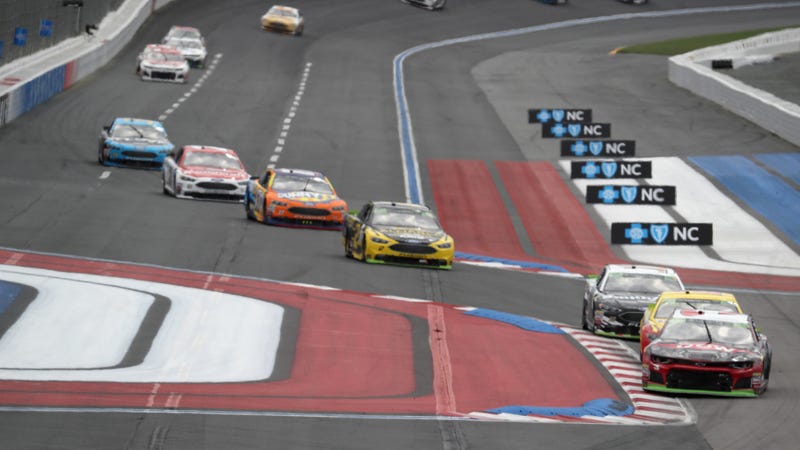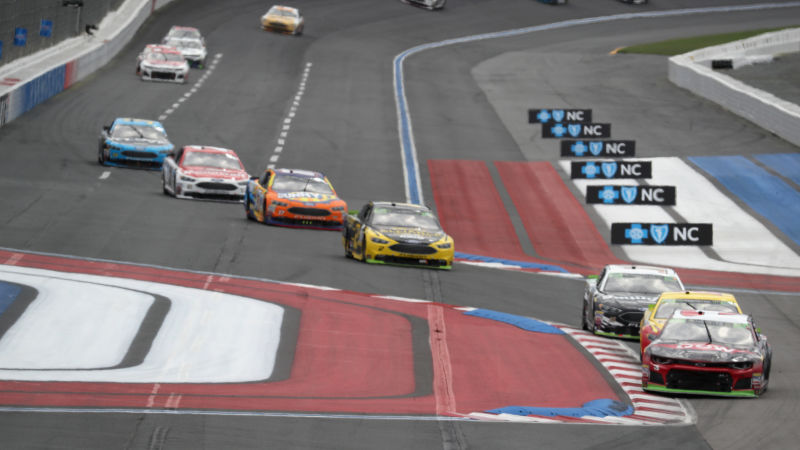
NASCAR wants the cars in its top-level Monster Energy NASCAR Cup Series to not string out like a broken bracelet from a Walmart claw machine, and encourage actual side-by-side/back-and-forth racing. NASCAR will try to do that, in part, by taking its Cup Series cars from about 800 horsepower down to 550.
NASCAR announced its new rules package for 2019 on Tuesday, which, depending on the race track, includes some big aerodynamic changes and restrictions on the engine. The changes are similar to what NASCAR did with its Cup Series All-Star race this year, which made the racing great to watch but didn’t get the best reviews from the people actually driving the cars.
Here’s the gist of the new aerodynamics and car package that’ll be used at all tracks in 2019, summarized from NASCAR’s press release:
- Rear spoiler will be eight inches tall by 61 inches in length next year, up from 2.375 inches by 61 inches this year
- Larger front splitter than this year, with a two-inch overhang
- Wider radiator pan, measuring 37 inches wide in the front and tapering to 31 inches at the rear
Advertisement
The release said NASCAR will use aerodynamic ducts on the front of the cars to “transfer air to the side of the car away from the front tires,” with the intent of making the racing closer, at certain oval tracks longer than a mile next year. The ducts won’t be used at road courses, smaller tracks and certain large ovals.
The aerodynamic changes are kind of the opposite of what NASCAR has done in the past few years, and even NASCAR recognized that in its announcement—it said these changes have “the intent of adding downforce to stabilize handling, a break from a trend of downforce reduction” between 2015 and 2018.
But aerodynamics isn’t the only change. NASCAR’s also cutting power in the Cup Series, dropping engines from the roughly 750 HP they’re at now to 550 HP at half of the races next year. That’ll be done with a tapered spacer, which has basically the same function as a restrictor plate like the ones used at Daytona and Talladega—lowering power by restricting airflow to the engine.
Advertisement
The restrictions, in NASCAR’s words, “both restrict the passage of air through the engine to reduce horsepower, but the tapered spacer’s funnel-shaped design allows for a slightly more efficient flow and throttle response.”
At five races the cars will get this smaller restricting spacer and no aero ducts. (Those races are both Pocono Raceway race dates, Atlanta Motor Speedway, Darlington Raceway and Homestead-Miami Speedway.)
Other tracks using the spacers will use the ducts.
And on short tracks and road courses neither the smaller spacer nor the ducts will be on the cars.
Advertisement
Because all of that is hard to visualize, here’s a photo of the 2018 NASCAR Cup Series rules package next to the the 2019 one announced this week:
There have been talks about NASCAR mandating this kind of rules package for next year since its Cup Series All-Star race over the summer, where reports are that the cars ran around 400 HP with restrictor plates.
Advertisement
The limits to the engine and aerodynamic changes in the All-Star gave the car out front less of an aero advantage over others, and cars shot past each other in a way that looked almost effortless at times—closer to what passing looks like with plates at Daytona and Talladega, and further from how labored passing can look with the current package and aero advantage for the leader at other tracks.
NASCAR thought about using a rules package similar to the All-Star one at other races this season, but a lot of teams and drivers were not having it. Despite how entertaining the race was, former Cup Series champions Kevin Harvick and Kyle Busch had some convincing arguments against it.
Here’s what Busch said earlier this year, via ESPN:
“It’s not necessarily what I signed up for to be a race car driver to bring the whole field closer together and have it dictated by some type of a plate race,” Busch said.
“But if that’s what we’re going to have going forward, then I guess I either need to think about how to get really good at it or getting out of it, so we’ll see what happens.”
Advertisement
And here’s Harvick, also from ESPN:
“Just remember this,” Harvick cautioned after his victory Saturday night. “There was a large buzz about the low downforce package that we currently race when we left the All-Star Race one year.”
He’s right. When teams have time to work on new rules and throw their resources at them, the results can change.
Advertisement
Either way, what’s done is done, and NASCAR’s taking a drop in power at a lot of tracks next year in order to hopefully pull cars closer together. Regardless of what does happen in the long run, we can expect good racing for at least a few weekends—until teams “figure out” (learn how to cheat?) the new package, like Harvick said.















